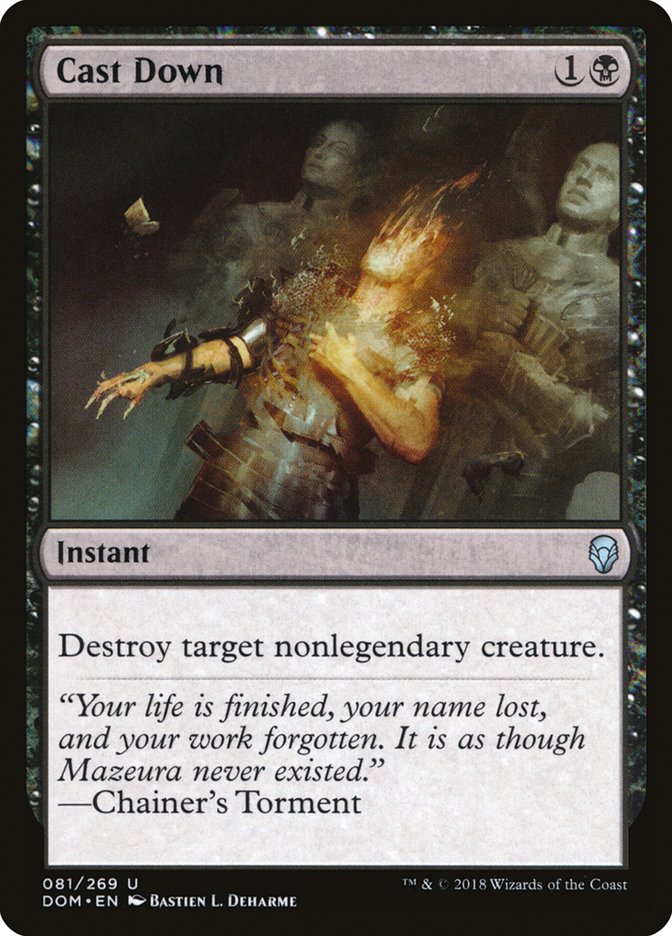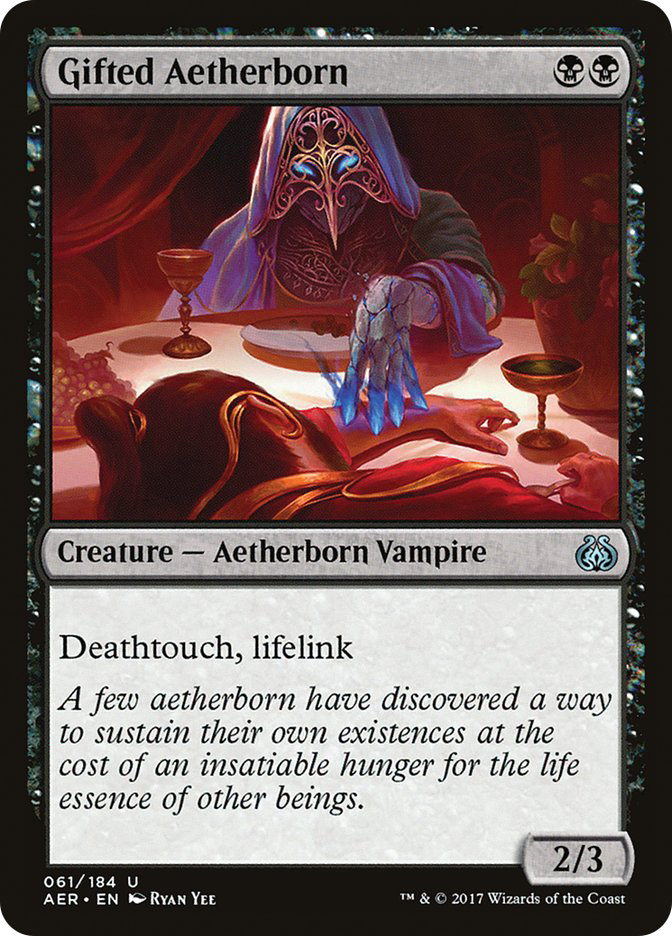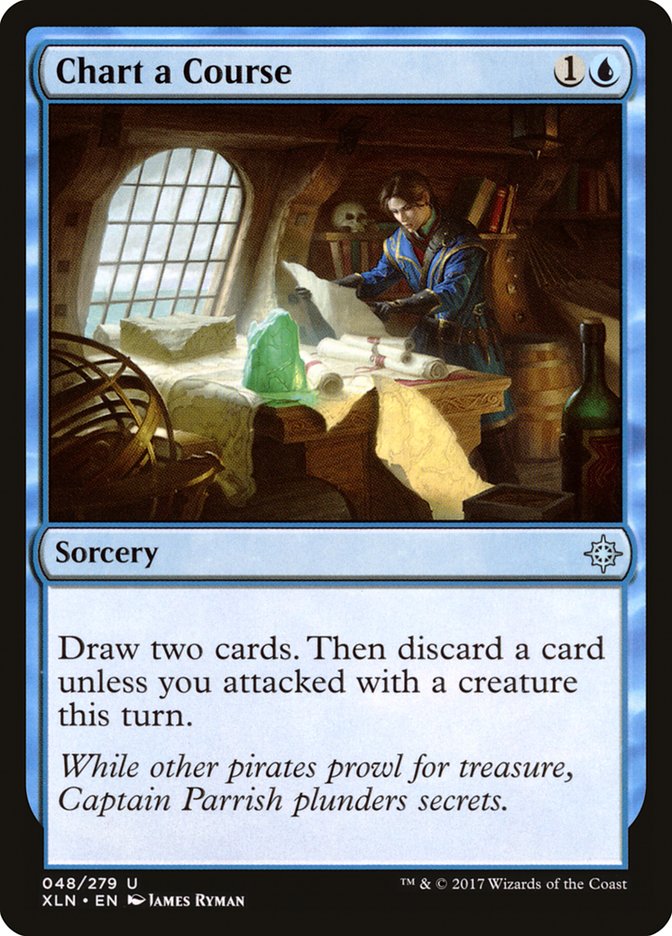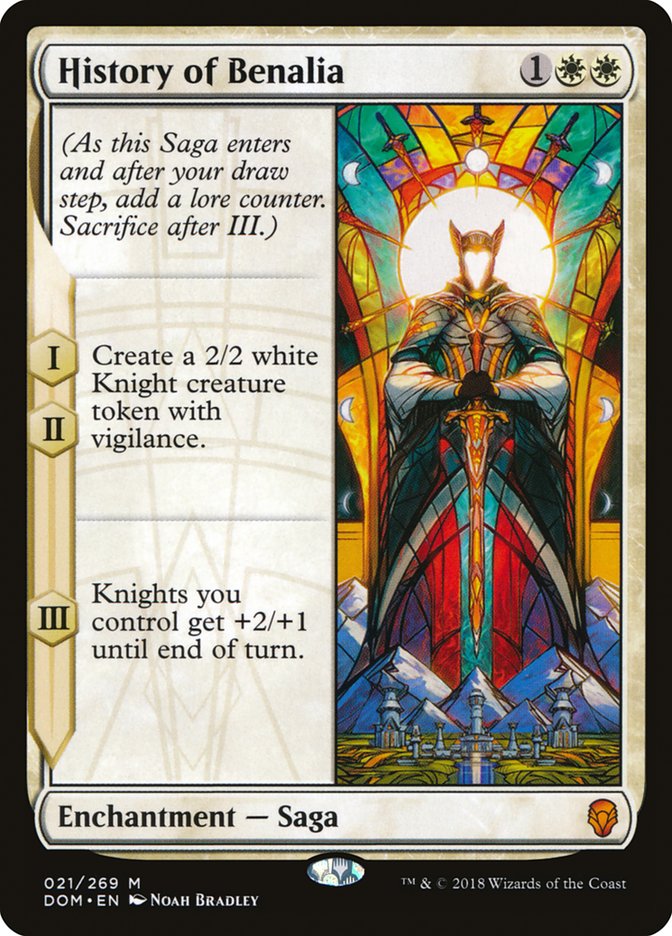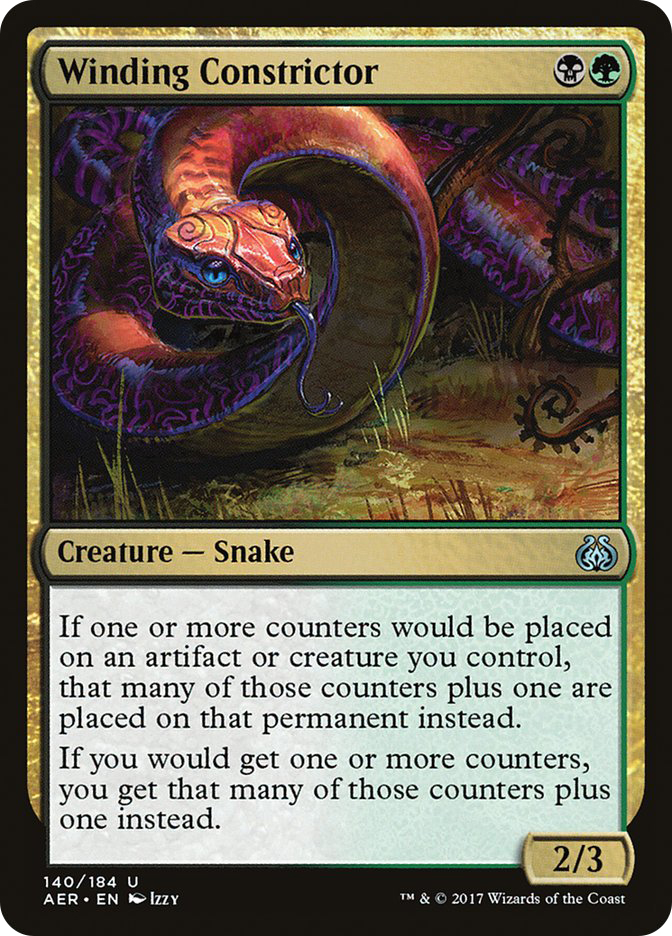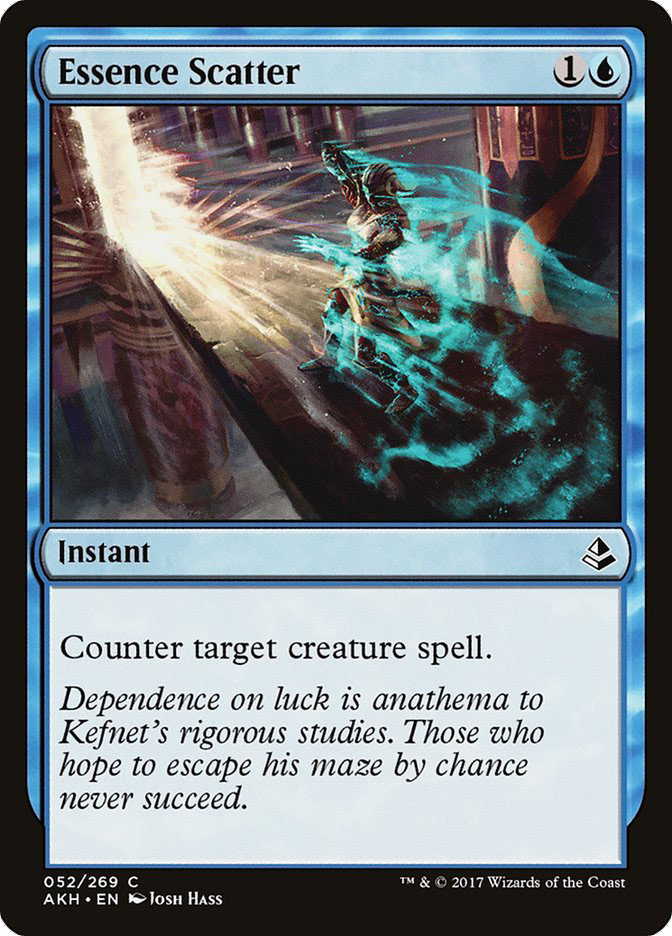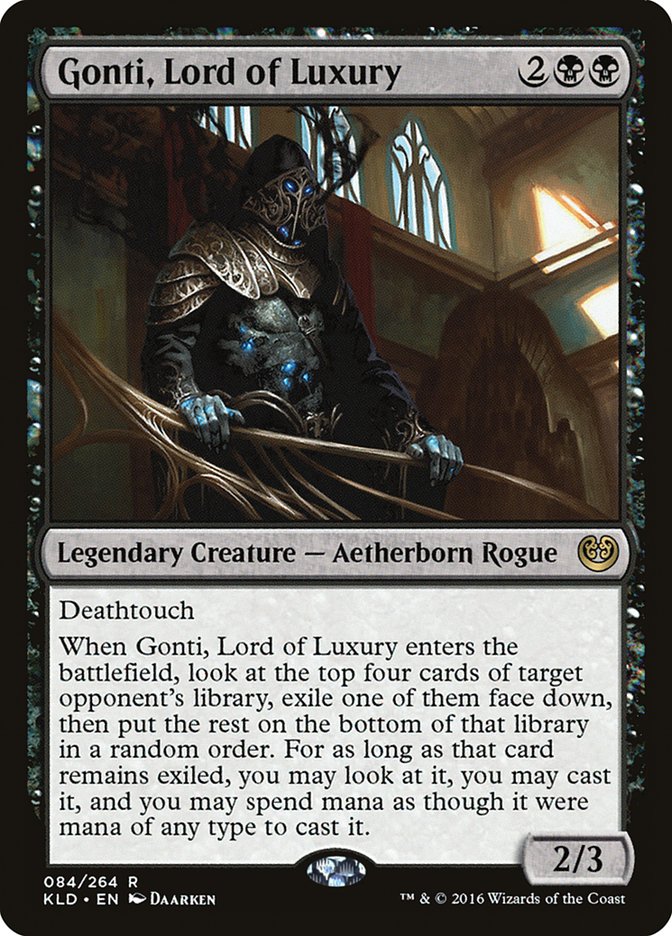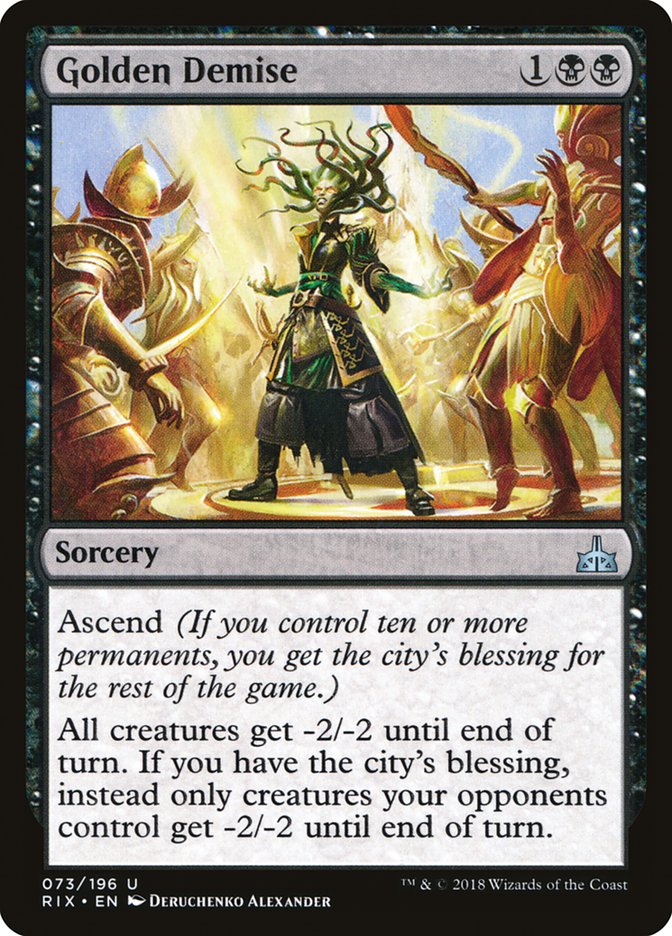Has the day already come where I have to put down my favorite card in Standard? Is Dominaria so powerful that even The Scarab God isn’t powerful enough to combat it?
These questions keep whirling around in my head as I manically sift through decklists, cards, and articles, trying to find my footing. I’m not ready to give up my beloved, and I’ll do everything in my power to hold onto it for just a little bit longer. That is, if it’s still good enough, and today we’re going to try to answer that question.
U/B Midrange was my deck of choice last season, and I don’t really have any regrets for choosing it. I may not have found myself in the Top 8 of a Grand Prix with it, but both of my finishes were respectable. At Grand Prix Memphis I finished 11-3-1, and in Seattle I took a heartbreaking ninth place on tiebreakers. In both events I can look back and find places I screwed up, but neither time can I blame the deck itself. For me it was the best possible choice.
There was a justifiable debate to be had between playing Grixis Energy or U/B Midrange. The main discrepancy between the decks was the removal. Both decks played similar late-games, but Grixis Energy was simply stronger against the aggressive decks. U/B Midrange was the stronger choice against the other The Scarab God decks, yet could still tango with the rest of the field.
I bring this up, not to continue the debate, but to bring up a crucial point: Grixis Energy no longer has indisputable superiority when it comes to the removal department.
The printing of this removal spell is huge for U/B Midrange in a vacuum. Finally the deck has something to bridge Fatal Push and Vraska’s Contempt. Sure, it’s a conditional removal spell, but it’s at least something, especially for a deck that specifically struggled in this department. This card could be a game-changer.
Or so I hoped.
I’m getting a little ahead of myself, though. One of the more important things I talked about a few weeks back was defining what you think you know. It’s vital to break down what you think you know before building upon your foundation. It would be a mistake to just lazily update my list from Seattle after predicting what’s to come from Dominaria. Instead I need to break down everything I learned from this past format to move forward as objectively as possible.
The U/B Midrange Breakdown
On the surface, the deck was designed to win via inevitability through The Scarab God. Clearly the format grew around this, making it less reliable to simply slam the card on Turn 5 and ride it to victory, but that did happen more often than it should have. Sometimes they just didn’t have the answer.
Champion of Wits, Liliana, Death’s Majesty, and Torrential Gearhulk were all cards that helped imitate the card advantage deity until it finally got online. Even though it was possible to win games without The Scarab God, it rarely did in fact happen. This is the core of the strategy. Sure, cards like Glint-Sleeve Siphoner; Gonti, Lord of Luxury; and Walking Ballista were part of the strategy for most of the season, but I would never call any of them sacred cows. They were just good cards that helped the strategy.
To this day I’ll still never understand why the deck played Walking Ballista. I mean, I get why on a tactical level, but it always felt badly out of place. Initially I valued the card, given how “safe” it was for Chandra, Torch of Defiance to enter the battlefield and minus to kill a creature. Walking Ballista punished that commonly used line. It was also nice to have access to in Glint-Sleeve Siphoner mirrors, as keeping Fatal Push in after sideboarding felt miserable. Besides that, it was just Walking Ballista. Maybe the card’s just that good, even without any synergies.
In the beginning I played Gifted Aetherborn in the maindeck alongside Chart a Course. I’m unsure if Chart a Course was worthy of its maindeck position, but I was rather happy with Gifted Aetherborn. It didn’t seem like anyone else was, though, and it quickly became mainstream to remove it from the deck entirely.
At the time, U/B Control, U/B Midrange, Grixis Energy, and Mono-Red Aggro seemed to control the metagame. Besides Mono-Red Aggro, the decks where you wanted the card, like G/W Tokens and W/B Vampires, just disappeared after Grand Prix Memphis.
Matthew Foulkes, self-proclaimed best Standard player in the world, quickly popularized Dusk Legion Zealot as a replacement, as it was much better against the more controlling strategies, yet also traded for value against Mono-Red Aggro. I never subscribed to this philosophy, as I always thought the card to be underpowered. It was a placeholder creature in a previously occupied creature slot. Really, it was just some bush-league deckbuilding, if you ask me.
At the end of the season, Gifted Aetherborn was back in the deck’s sideboard as a response to all the aggressive decks popping up, like G/R Monsters, Sultai Constrictor, and R/B Vehicles. I didn’t practice for Grand Prix Seattle, so I also had four in my sideboard, but I wished they were in the maindeck by the time the event concluded. They just came in against almost every matchup.
Looking back, it’s easy to see how malleable U/B Midrange truly is. Both colors have a plethora of playable cards to choose from. The issue is not having answers to popular problems, particularly not having enough of the right answers in the face of a wide-open metagame. If there are too many decks out there, the strategy can struggle to have the density needed to fight everything. Something will inevitably fall through the cracks, and matches will be lost.
Moving forward, we introduce Dominaria into the mix. The set’s full of cards that could be played in U/B Midrange, yet also improve many other decks while also creating a few strategies as well. Choosing to continue working on a deck like U/B Midrange can get dicey, as predicting the metagame is crucial for playing the right answers.
Do you know how difficult that’s going to be? Honestly, I don’t even know if it’s possible.
It’s usually safe to say that Week 1 Standard is when the format’s at its most polarized, as trying to play a midrange deck is a fool’s errand for reasons previously stated. There will be Mono-Red Aggro decks trying out the new Goblin Chainwhirler, white decks running History of Benalia and Benalish Marshal, and also control decks trying out Teferi, Hero of Dominaria. That’s not even accounting for those who continue to play decks revolving around God-Pharaoh’s Gift and Winding Constrictor! What is a midrange player to do?
One thing I always keep in mind when I’m in this predicament is remembering how difficult it is for midrange decks to beat dedicated control Game 1. I lean on this philosophy when I’m trying to justify playing a midrange deck. I also only move forward from this place if I believe there will be a much higher percentage of creature-based decks than control. Since it’s almost always the case, we can simply start working on a maindeck that fights against the creature-based decks we expect to show up.
One deck to take note of is Sultai Constrictor. It was by far U/B Midrange’s worst matchup last season, but the deck ended up not being as good as previously advertised. For a while there it was picking up steam, which scared every U/B Midrange player, but the deck fell flat on its face in Seattle. In the end it just wasn’t good enough in the face of the other decks in the metagame. Since I wouldn’t expect too much midrange right out of the gates, I would assume this deck to be a tiny portion of the metagame.
So what do we want in our deck if we’re trying to beat up on creatures? Well, for starter,s we need to decide on the removal suite. The narrowed-down options are Fatal Push, Cast Down, Censor, Essence Scatter, Supreme Will, Commit // Memory, Vraska’s Contempt, and Ravenous Chupacabra. Some of you may have caught that I didn’t bring up Syncopate or Blink of an Eye. Both of these cards have their homes, but U/B Midrange won’t be one of them.
I could be wrong, but my philosophy when it comes to this deck is to play the best version of an effect, as the deck centers around Champion of Wits. When cards are bad, you get to “loot” them away. There’s no reason to play catch-all cards like Syncopate when you have the ability to discard them anyway. I’d much rather fill my deck with powerful and efficient spells that do a job well. When that job doesn’t need doing, they can get removed from the hand quite easily.
Essence Scatter became a very good card for U/B Midrange at the end of the metagame, but that was mainly due to the fear of Sultai Constrictor. Some of those creatures were just so difficult to deal with that it was easier to have countermagic for them. That is likely to change now that the deck doesn’t seem like it will be all that popular, but cards like History of Benalia will also be in circulation. Holding up mana to eventually have this card cast against you could be devastating.
Essence Scatter does counter Knight of Grace, but we’re kind of banking on that card not being good enough for Standard. If it does end up becoming a mainstream creature, this article is all for naught, as U/B really can’t beat this card.
Cast Down is another good reason for the deck to lean less on Essence Scatter. It’s a pretty good answer to three-drops, which was one of the counterspell’s main responsibilities. Well, that and counter Torrential Gearhulk. Just saying that means that I wouldn’t want to cut Essence Scatter altogether, but I could see going down to just one copy. Like I said earlier, I really do enjoy playing one-ofs in this deck!
We must look at the creature base before moving too much further into figuring out what spells to play. I’m still going to play Glint-Sleeve Siphoner and Champion of the Wits for now, but what I’m most curious about is whether I should play Ravenous Chupacabra; Gonti, Lord of Luxury; and/or Gifted Aetherborn. I already know I’m removing Walking Ballista from the deck. At least for now. Maybe this is a mistake, but I just don’t see why it’s necessary now that we have Cast Down.
I’m pretty sold on going back to playing Gifted Aetherborn in the maindeck, especially for Week 1. It’s a really good card, after all, and only underperforms against control and the “mirrors.” Ravenous Chupacabra also sounds appealing, as I think it will be important to create a battlefield presence while interacting with some of these aggressive decks. I see Benalish Marshal and just want to kill it with a Chupacabra!
One card I’m really unsure about is Gonti, Lord of Luxury. I get it. Gonti’s my jam. Hell, I even wrote an article titled “Brad Nelson, Lord of Luxury,” and it wasn’t about how I love sitting around getting fanned all day long while eating grapes.
I just don’t know if it’s going to be a great maindeck card now that I expect more red and white aggressive decks along with God-Pharaoh’s Gift decks. You need to be able to find valuable cards off its ability, and I just don’t know if that will be the case right now. As sad as it is to say, it might be time to bench the card, or at least reducing it to one copy in the maindeck.
Am I just building a Brawl deck?
Anyway, after thinking about it for a while, this is my first draft of U/B Midrange.
Creatures (19)
- 1 Gonti, Lord of Luxury
- 2 Torrential Gearhulk
- 4 Glint-Sleeve Siphoner
- 4 Gifted Aetherborn
- 3 The Scarab God
- 3 Champion of Wits
- 2 Ravenous Chupacabra
Planeswalkers (2)
Lands (26)
Spells (13)

Seeing this list on paper makes me fear for my job, as it does resemble what I played back in Memphis so many months ago. It sort of looks like I just copy-and-pasted that list and lazily made updates, even though that’s what I was trying not to do!
All of these cards do in fact have updated thoughts behind them. For example, Chart a Course seems like a good card again if we believe Gifted Aetherborn to be a strong addition to the maindeck. Just being able to play multiple spells a turn is key against aggressive decks, and Champion of Wits isn’t as vital as a four-of when we’re not facing that many mirrors. I also rather enjoy having access to the card when I’m playing more than one Liliana, Death’s Majesty.
The sideboard may look all over the place, but it needs to interact heavily with control decks and U/R God-Pharaoh’s Gift. That’s why we’re playing a Dispossess, which hits both decks. Another crossover card is Sorcerous Spyglass, which helps fight Gate to the Afterlife and decks like R/B Vehicles. Being able to shut down every copy of Heart of Kiran on Turn 2 is particularly powerful. At worst it can stop Chandra, Torch of Defiance, which is one of the more difficult cards for this deck to beat when Vraska’s Contempt isn’t available.
One card that might not be necessary is Golden Demise, but I’ve liked it in combination with Negate against U/R God-Pharaoh’s Gift and any token-based decks that may also pop up. It also interacts well against History of Benalia, which I believe will see ample play this weekend. Oh, and it kills that stupid Knight of Grace too!
In the end, there’s no way of knowing if this list or even deck will be good enough for Standard moving forward. Even though all I want is for this deck to be good, what I want isn’t always what I’ll get. It’s important to know that, as it’s easy to get stuck trying to make something work when everything’s against you. Are we fighting the tide, or in fact perfecting perfection? I guess we’ll find out this weekend in Atlanta when one of you takes this list and wins the whole thing!
Wait, who am I kidding? We all know Owen Turtenwald supplies the tournament-winning decklists around here.


